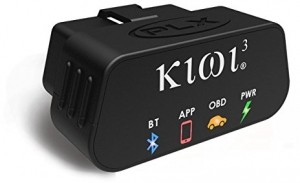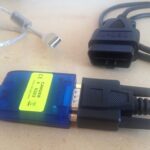For car enthusiasts and those keen on monitoring their vehicle’s performance, gauges are indispensable tools. Traditionally, setting up car gauges meant a complex installation process, but the advent of OBD2 ports simplified things significantly for modern vehicles. However, what are your options when seeking the best gauge setup, especially if you’re dealing with a vehicle without an OBD2 port or simply prefer an alternative approach? Let’s explore.
For many, the OBD2 port is the gateway to easily integrating digital gauges. Devices like the PLX Devices Kiwi 3 Bluetooth OBD2 adapter exemplify this convenience. This compact adapter plugs directly into your car’s OBD2 port, wirelessly transmitting real-time data to your smartphone, tablet, or other devices.
The Kiwi 3 stands out as a top-tier OBD2 adapter for several reasons:
- Discreet Size: Its remarkably small form factor, protruding just 0.68 inches from the OBD port, makes it virtually unnoticeable once installed. This is ideal for those who prefer a clean, uncluttered look in their vehicle’s cabin.
- High Speed Data: Kiwi 3 boasts data transmission speeds up to four times faster than many competitors. This rapid refresh rate ensures smooth, real-time gauge readings, crucial for performance monitoring.
- Low Power Consumption: Designed for permanent installation, the Kiwi 3 consumes minimal power (0.2W active, 0.05W sleep), eliminating concerns about battery drain even when left plugged in continuously.
- Broad Compatibility: Kiwi 3 is cross-platform compatible, working seamlessly with iOS, Android, and Windows Mobile devices. It supports all cars and light trucks sold in the US post-1996, covering the vast majority of vehicles on the road.
While OBD2 adapters offer a straightforward gauge solution for compatible vehicles, what about setups for cars without OBD2 ports, or for users seeking a more traditional approach? In these cases, standalone gauges are the answer. These gauges operate independently, relying on direct sensor connections rather than digital data from the OBD2 system.
Standalone gauges typically involve installing physical sensors in your engine bay or other vehicle systems. For example, to monitor oil pressure, you would install an oil pressure sensor directly into the oil system. Similarly, coolant temperature, boost pressure, and air/fuel ratio gauges each require their own dedicated sensors.
While standalone gauge setups offer universal compatibility (working with any vehicle, regardless of OBD2 presence) and a classic aesthetic, they are more complex to install. They require running wires, mounting sensors, and potentially tapping into fluid lines. However, for older vehicles or those heavily modified for performance, standalone gauges can be the most reliable and accurate way to monitor critical parameters.
Ultimately, the “best gauge setup” depends on your vehicle and your preferences. For most modern vehicles with OBD2 ports, an OBD2 adapter like the Kiwi 3 offers an excellent balance of ease of installation, comprehensive data access, and modern features. If you are working with an older vehicle or desire a more traditional gauge setup, standalone gauges provide a robust and universally compatible alternative, albeit with a more involved installation process.

